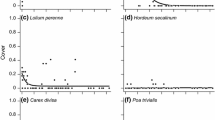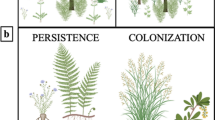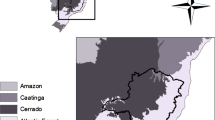Abstract
When investigating relationships between species’ niches and distributions, niches can be divided demographically, resulting in unique niches for different life stages. This approach can identify changing substrate requirements throughout a species’ life cycle. Using non-metric multidimensional scaling, we quantified microsite conditions associated with successful recruitment in the tundra landscape and successful seed production amongst adult trees of black spruce (Picea mariana) at subarctic treeline in Yukon, Canada to assess how life stage-specific requirements may impact the distribution of this widespread boreal tree species. Treeline ecotones in this region showed high heterogeneity in tundra microsites available for establishment. Black spruce exhibited changing microsite associations from germination to reproductive maturity, which were mainly driven by changes in plant community and soil moisture. These associations limit the microsites where individuals can establish and reproduce to a subset available within the heterogeneous landscape. Overall, we suggest that (1) substrates suitable for early recruitment are limited at the range edge; and (2) reproductive adults have a narrow niche, limiting successful seed production in adults and forming sink populations where suitable conditions are limited. Our multivariate assessment of microsite suitability can provide valuable insights into the spatial distribution of a species throughout its life cycle and identify life stage-specific constraints to range expansion.


Similar content being viewed by others
Data availability
Data are archived on dryad. https://doi.org/10.5061/dryad.573n5tbbc.
Code availability
Code will be available upon request.
References
Bates D, Maechler M, Bolker B, Walker S. (2015) Fitting linear mixed-effects models using lme4. Journal of Statistical Software 67 1–48
Batllori E, Camarero JJ, Ninot JM, Gutiérrez E (2009) Seedling recruitment, survival and facilitation in alpine Pinus uncinata tree line ecotones. implications and potential responses to climate warming. Global Eco Biogeography 18:460–472. https://doi.org/10.1111/j.1466-8238.2009.00464.x
Bertrand R, Gégout JC, Bontemps J (2011) Niches of temperate tree species converge towards nutrient-richer conditions over ontogeny. Oikos 120:1479–1488. https://doi.org/10.1111/j.1600-0706.2011.19582.x
Brehaut L, Brown CD (2022) Wildfires did not ignite boreal forest range expansion into tundra ecosystems in subarctic Yukon Canada. Plant Ecol. https://doi.org/10.1007/s11258-022-01242-9
Brodersen CR, Germino MJ, Johnson DM, Reinhardt K, Smith WK, Resler LM et al (2019) Seedling survival at timberline is critical to conifer mountain forest elevation and extent. Frontiers in Forests and Global Change 2:1–12. https://doi.org/10.3389/ffgc.2019.00009
Brooks ME, Kristensen K, Van Benthem KJ, Magnusson A, Berg CW, Nielsen A et al (2017) Glmmtmb balances speed and flexibility among packages for zero-inflated generalized linear mixed modeling. The R Journal 9:378–400. https://doi.org/10.3614/rj-2017-066
Brown CD, Liu J, Yan G, Johnstone JF (2015) Disentangling legacy effects from environmental filters of postfire assembly of boreal tree assemblages. Ecology 96:3023–3032. https://doi.org/10.1890/14-2302.1
Brown CD, Dufour-Tremblay G, Jameson RG, Mamet SD, Trant AJ, Walker XJ et al (2019) Reproduction as a bottleneck to treeline advance across the circumarctic forest tundra ecotone. Ecography 43:137–147. https://doi.org/10.1111/ecog.03733
Camarero JJ, Linares JC, García-Cervigón AI, Batllori E, Martínez I, Gutiérrez E (2017) Back to the future: The responses of alpine treelines to climate warming are constrained by the current ecotone structure. Ecosystems 20:683–700. https://doi.org/10.1007/s10021-016-0046-3
Campeau S, Rochefort L (1996) Sphagnum regeneration on bare peat surfaces: field and greenhouse experiments. J Appl Eco 33:599–608. https://doi.org/10.2307/2404988
Cranston BH, Hermanutz L (2013) Seed-seedling conflict in conifers as a result of plant-plant interactions at the forest-tundra ecotone. Plant Ecolog Divers 6:319–327. https://doi.org/10.1080/17550874.2013.806603
Davis EL, Hager HA, Gedalof Z (2018) Soil properties as constraints to seedling regeneration beyond alpine treelines in the Canadian rocky mountains. Arct Antarct Alp Res 50:1–15. https://doi.org/10.1080/15230430.2017.1415625
Dufour-Tremblay G, De Vriendt L, Lévesque E, Boudreau S (2012) The importance of ecological constraints on the control of multi-species treeline dynamics in Eastern Nunavik, Québec. Am J Botany 99:1638–1646. https://doi.org/10.3732/ajb.1200279
Eremko RD, Edwards DGW, Wallinger D (1989) A guide to collecting cones of British Columbia conifers. Forestry Canada, Victoria, BC
Ettinger AK, Ford KR, Hille Ris Lambers J (2011) Climate determines upper, but not lower, altitudinal range limits of Pacific Northwest conifers. Ecology 92:1323–1331. https://doi.org/10.1890/10-1639.1
Franco M, Silvertown J (1996) Life history variation in plants: an exploration of the fast-slow continuum hypothesis. Philosophical Transactions Royal Soc London Series b: Bio Sci 351:1341–1348. https://doi.org/10.1098/rstb.1996.0117
Harper JL (1977) Population biology of plants. Academic Press Inc., London, U.K.
Harsch MA, Hulme PE, McGlone MS, Duncan RP (2009) Are treelines advancing? a global meta-analysis of treeline response to climate warming. Ecol Lett 12:1040–1049. https://doi.org/10.1111/j.1461-0248.2009.01355.x
Hesketh M, Greene DF, Pounden E (2009) Early establishment of conifer recruits in the northern rocky mountains as a function of postfire duff depth. Can J for Res 39:2059–2064. https://doi.org/10.1139/X09-120
Hobbie SE, Nadelhoffer KJ, Högberg P (2002) A synthesis: The role of nutrients as constraints on carbon balances in boreal and arctic regions. Plant Soil 242:163–170. https://doi.org/10.1023/A:1019670731128
Holtmeier FK, Broll G (2005) Sensitivity and response of northern hemisphere altitudinal and polar treelines to environmental change at landscape and local scales. Global Ecology Biogeography 14:395–410. https://doi.org/10.1111/j.1466-822X.2005.00168.x
Houle G, Filion L (2003) The effects of lichens on white spruce seedling establishment and juvenile growth in a spruce-lichen woodland of subarctic Québec. Écoscience 10:80–84. https://doi.org/10.1080/11956860.2003.11682754
Hu FS, Brubaker LB, Gavin DG, Higuera PE, Lynch JA, Rupp TS, Tinner W (2006) How climate and vegetation influence the fire regime of the Alaska boreal biome: The holocene perspective. Mitigation Adaptation Strategies Global Change 11:829–846. https://doi.org/10.1007/s11027-005-9015-4
Hutchinson GE (1957) Concluding remarks. Cold Spring Harbor Symposia on Quant Bio 22:415–427. https://doi.org/10.1101/SQB.1957.022.01.039
Johnston W, Smith T. (1985) Black Spruce. Pages 96–98 Silvicultural systems for the major forest types of the United States
Johnstone JF, Chapin FS (2006) Effects of soil burn severity on post-fire tree recruitment in boreal forest. Ecosystems 9:14–31. https://doi.org/10.1007/s10021-004-0042-x
Johnstone JF, Boby L, Tissier E, Mack M, Verbyla D, Walker X (2009) Postfire seed rain of black spruce, a semiserotinous conifer, in forests of interior Alaska. C J Forest Res 39:1575–1588. https://doi.org/10.1139/X09-068
Kambo D, Danby RK (2017) Constraints on treeline advance in a warming climate: a test of the reproduction limitation hypothesis. J Plant Eco 11:411–422. https://doi.org/10.1093/jpe/rtx009
Kambo D, Danby RK (2018) Factors influencing the establishment and growth of tree seedlings at Subarctic alpine treelines. Ecosphere. https://doi.org/10.1002/ecs2.2176
Kasischke ES, Verbyla DL, Rupp TS, McGuire AD, Murphy KA, Jandt R et al (2010) Alaska’s changing fire regime—implications for the vulnerability of its boreal forests. Canadian J Forest Res 40:1313–1324. https://doi.org/10.1139/X10-098
Lee-Yaw JA, Kharouba HM, Bontrager M, Mahony C, Csergo AM, Noreen AME et al (2016) A synthesis of transplant experiments and ecological niche models suggests that range limits are often niche limits. Ecol Lett 19:710–722. https://doi.org/10.1111/ele.12604
Legendre P, Legendre LF (2012) Numerical Ecology, 3rd edn. Elsevier, Oxford, U.K.
Lett S, Dorrepaal E (2018) Global drivers of tree seedling establishment at alpine treelines in a changing climate. Funct Ecol 32:1666–1680. https://doi.org/10.1111/1365-2435.13137
Maguire B (1973) Niche response structure and the analytical potentials of its relationship to the habitat. Am Nat 107:213–246. https://doi.org/10.1086/282827
Malcolm JR, Markhan A, Neilson RP, Garaci M (2002) Estimated migration rates under scenarios of global climate change. J Biogeography 29:835–849. https://doi.org/10.1046/j.1365-2699.2002.00702.x
Máliš F, Kopecký M, Petřík P, Vladovič J, Merganič J, Vida T (2016) Life stage, not climate change, explains observed tree range shifts. Global Change Bio 22:1904–1914. https://doi.org/10.1111/gcb.13210
Mamet SD, Kershaw GP (2013) Age-dependency, climate, and environmental controls of recent tree growth trends at subarctic and alpine treelines. Dendrochronologia 31:75–87. https://doi.org/10.1016/j.dendro.2012.08.002
Manley B. (2006) Randomization, bootstrap and Monte Carlo methods in biology. 3rd edition. Chapman and Hall/CRC
McCune B, Grace J. (2002) Analysis of ecological communities. MJM Software Design, Glenden Beach, Oregon USA
Mekonnen ZA, Riley WJ, Berner LT, Bouskill NJ, Torn MS, Iwahana G et al (2021) Arctic tundra shrubification: a review of mechanisms and impacts on ecosystem carbon balance. Environ Res Lett 16:053001. https://doi.org/10.1088/1748-9326/abf28b
Müller LLB, Albach DC, Zotz G (2018) Growth responses to elevated temperatures and the importance of ontogenetic niche shifts in Bromeliaceae. New Phytol 217:127–139. https://doi.org/10.1111/nph.14732
Oksanen J, Kindt R, Legendre P, O’Hara B, Stevens M, Oksanen MJ, Suggests M (2007) The vegan package. Community ecology package 10:631–637
Parrish JAD, Bazzaz FA (1985) Ontogenetic niche shifts in old-field annuals. Ecology 66:1296–1302. https://doi.org/10.2307/1939182
Ping CL, Jastrow JD, Jorgenson MT, Michaelson GJ, Shur YL. (2015) Permafrost soils and carbon cycling. Soil 1:147–171
Pulliam HR (2000) On the relationship between niche and distribution. Ecol Lett 3:349–361. https://doi.org/10.1046/j.1461-0248.2000.00143.x
Quero JL, Gómez-Aparico L, Zamora R, Maestre FT (2008) Shifts in the regeneration niche of an endangered tree (Acer opalus ssp. granatense) during ontogeny: Using an ecological concept for application. Basic Appl Ecol 9:635–644. https://doi.org/10.1016/j.baae.2007.06.012
R Core Team (2019) R: A language and environment for statistical computing. R Foundation for Statistical Computing, Vienna, Austria
Rees WG, Hofgaard A, Boudreau S, Cairns DM, Harper K, Mamet S et al (2020) Is subarctic forest advance able to keep pace with climate change? Glob Change Biol 26:3965–3977. https://doi.org/10.1111/gcb.15113
Robertson GP, Sollins P, Ellis BC, Lajtha K (1999) Exchangeable ions, pH, and cation exchange capacity Standard soil methods for long-term ecological research. Oxford University Press, New York USA
Smith C, Meikle J, Roots C (2004) Ecoregions of the Yukon Territory: Biophysical Properties of Yukon Landscapes. Summerland, BC
Stjern CW, Lund MT, Samset BH, Myhre G, Forster PM, Andrews T et al (2019) Arctic amplification response to individual climate drivers. J Geo Res Atmospheres 124:6698–6717. https://doi.org/10.1029/2018JD029726
Tarnocai C, Smith CAS, Fox CA. (1993) International tour of permafrost affected soils: The Yukon and Northwest Territories of Canada Ottawa
Wheeler JA, Hermanutz L, Marino PM (2011) Feathermoss seedbeds facilitate black spruce seedling recruitment in the forest-tundra ecotone (Labrador, Canada). Oikos 120:1263–1271
Zasada JC, Sharik TL, Nygren M (1992) The reproductive process in boreal forests A systems analysis of the global boreal forest. Cambridge University Press, Cambridge, UK
Zuur AF, Ieno EN, Walker NJ, Saveliev AA, Smith GM (2009) Mixed effects models and extensions into ecology with R. Spring Science and Business Media, Page New York, NY
Acknowledgements
We gratefully acknowledge the Vuntut Gwitchin First Nation for permission to conduct this research on their lands. We are grateful to L. Brehaut and K. Reid for data collection and field logistics; L. Rees, G. Riefesel and B. Ronayne for laboratory assistance; and A. Hargreaves, Y. Wiersma, J. Williams, P. Marino, K. Reid, L. Walker, L. Brehaut, H. Baehre, J. Sullivan and two anonymous reviewers for valuable comments on previous versions of this manuscript.
Funding
This work was supported by the Natural Sciences and Engineering Research Council of Canada, the Northern Scientific Training Program, the Association of Canadian Universities for Northern Research, the W. Garfield Weston Foundation, and the Royal Canadian Geographical Society.
Author information
Authors and Affiliations
Contributions
KG. and CB. conceived the ideas, designed methodology, and collected the data; KG. analyzed the data and led the writing of the manuscript; CB. contributed critically to data analysis and drafts of the manuscript. Both authors gave final approval for publication.
Corresponding author
Ethics declarations
Conflict of interest
The authors declare that they have no conflict of interest.
Ethical approval
Not applicable.
Consent to participate
Not applicable.
Consent for publication
Not applicable
Additional information
Communicated by Melinda D. Smith.
Our multivariate approach enables us to quantify how microsites species occupy change across their life cycle, informing our understanding of species’ spatial distributions and life stage-specific hurdles to range expansion. We apply this method at northern black spruce range edges and identify strict environmental characteristics associated with successful recruitment and seed production. Suitable substrates for these two demographic transitions are limited at the range edge, explaining in part their lack of range expansion under ongoing climate change.
Supplementary Information
Below is the link to the electronic supplementary material.
Rights and permissions
Springer Nature or its licensor (e.g. a society or other partner) holds exclusive rights to this article under a publishing agreement with the author(s) or other rightsholder(s); author self-archiving of the accepted manuscript version of this article is solely governed by the terms of such publishing agreement and applicable law.
About this article
Cite this article
Goodwin, K.J.A., Brown, C.D. Integrating demographic niches and black spruce range expansion at subarctic treelines. Oecologia 201, 19–29 (2023). https://doi.org/10.1007/s00442-022-05293-7
Received:
Accepted:
Published:
Issue Date:
DOI: https://doi.org/10.1007/s00442-022-05293-7




